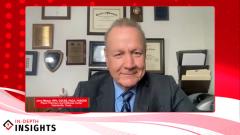
Patient Assistance Programs in Patients with Diabetes
Pharmacy experts share insights on the impact of assistance programs offered for patients with diabetes.
Episodes in this series

Jerry Meece, RPh, CDCES, FACA, FADCES: You mentioned pharmacy programs. How much can they help? What has been your experience in working with patients and companies with pharmacy programs? Sometimes we get overwhelmed with all the coupons. What do you do with that?
Jennifer D. Goldman, PharmD, RPh, CDCES, BC-ADM, FCCP: Patient-assistance programs are a lot easier to apply for than they were 10 years ago. Now you can do it online, so patients can do it. We don’t have to do it for them. You and I have a little more time built in to our schedules. A lot of pharmacists who have a couple of minutes have a lot of touch points with those patients, because oftentimes those patients are going to the pharmacy monthly or every 3 months. But if you have only a couple of minutes directing patients to the website, they can go online, set up an account, and fill in the paperwork. The only thing they need to do is bring in a prescription form and have their provider fill it out, sign it, and then send it in. Sometimes they have to include tax information. Oftentimes, it isn’t copies of it. They just have to fill in information.
What’s spectacular is that in the past, a lot of patient-assistance programs were only for people who didn’t have insurance. But we both know that there are people who are underinsured, have to pay deductibles, or are in that Medicare donut hole. Patient-assistance programs will provide free medications to lots of patients, even if they have income or insurance.
Jerry Meece, RPh, CDCES, FACA, FADCES: Not long ago, you told me about someone who thought they made too much money to get any help. In a family situation, they qualified when no one thought they would.
Jennifer D. Goldman, PharmD, RPh, CDCES, BC-ADM, FCCP: Absolutely. It’s surprising. The only way to know what that income limitation is. In that situation, this couple had made $70,000 but still couldn’t afford their medications and was able to apply. That’s certainly an option. There are other programs if you don’t have an income like that, in which you could get extra help or more government support. Pharmacists can lead patients to where to find that information.
Jerry Meece, RPh, CDCES, FACA, FADCES: We love our patients. We want to help everybody. No wonder we’re the most trusted and loved profession in the world. We give everything away for free, but we take it upon ourselves to spend this time. If I could throw a nugget to our pharmacists, it’s to start them out—even have something made up—and show them where the website is and what’s needed to be done with your form and what they need to do, but let them do the leg work. Put part of this on them so that they’re doing the work, they’re saving the money, and you don’t have to do everything. Be the guide on the side. Let them do a lot of the legwork. It makes a difference. Then you can help them. That’s great. The new insulin companies with some of their benefits are making things more affordable. In a lot of cases, people aren’t aware of it—even pharmacists.
Jennifer D. Goldman, PharmD, RPh, CDCES, BC-ADM, FCCP: Depending on the company, major insulin companies have programs where, with or without insurance, you’d pay no more than $35 or $99 a month for insulin.
Jerry Meece, RPh, CDCES, FACA, FADCES: It’s something we all need to be aware of in our daily practice.
Transcript edited for clarity.
Newsletter
Pharmacy practice is always changing. Stay ahead of the curve with the Drug Topics newsletter and get the latest drug information, industry trends, and patient care tips.































































































































